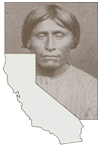![]()

Five Views: An Ethnic Historic Site Survey for California
MENU
Introduction
pre-1769
1769-1848
1849-1879
1880-1904
1905-1933
1934-1964
1965-1980
Historic Sites
Selected References

A History of American Indians in California:
HISTORIC SITES
Cupa
San Diego County
Cupa, also called Warner Springs Ranch or Agua Caliente Village, is located north of Interstate 8 and east of Lake Henshaw on State Highway 79 near Warner Springs, California. The historic 200-acre Cupeno Indian village site is now abandoned, but there remains evidence of its historical importance. A number of recently abandoned residences above the old village do not disturb the site itself. Settling ponds and swimming pools constructed on Agua Caliente Creek at the old resort are now in a state of disrepair. The beautiful valley of Agua Caliente in which the village was situated lies at an altitude of 3,000 feet, and is home for many kinds of wildlife, native shrubs, grass, and evergreen oak trees.
The Cupeno Indians were already living at Cupa before the Spanish arrived in California in the 1700s. They continued to reside at Agua Caliente after the American occupation of California in 1847-48. Once the Americans arrived, however, Antonio Garra, a Cupeno from Warners Ranch, attempted to organize a coalition of various Southern California Indian tribes to drive out all of the Whites. The attempt failed, Garra was executed, and Cupa, the village at Warner Springs, was burned.
Although Cupa was on Indian land, Juan Jose Warner, a naturalized Mexican citizen, received the land in a grant from the Mexican Government on November 28, 1844. Warner, like most other large landholders in California at the time, depended chiefly on Indian labor. The village of Cupa provided most of Warner's workforce. Some members of the tribe, during the time they worked for Warner, moved to the vicinity of the ranch house, and built their own adobe huts. According to Julio Ortega, one of the oldest members of the Cupeno tribe, Warner set aside about 16 miles of land surrounding the hot springs as the private domain of the Indians. Warner encouraged the Cupenos to construct a stone fence around their village, and to keep their livestock separated from that of the ranch. Ortega felt that, had the village created its own boundaries, the Cupenos would still live there today. (Morrison, 1962:21) In observing the Cupenos' living conditions in 1846, W. H. Emory, brevet major with the Corps of Engineers, described the Indians as being held in a state of serfdom by Warner, and as being ill-treated. (Out West, May 1902:471)
After European contact and prior to the time of their eviction, the Cupenos sold milk, fodder, and some craftwares to Whites. The women made lace and took in laundry which they washed in the hot springs. The men carved wood and manufactured saddle mats for horses. They also raised cattle and cultivated 200 acres of land.
In 1849, Warner was arrested for consorting with the Mexican government and was taken to Los Angeles. In 1880, after numerous suits and countersuits, all titles to the main portion of Warner's Ranch became the property of John G. Downey. In the 1890s, the owners of Cupa began proceedings to evict the Indians. Legal proceedings continued until 1903, when the decision of Barker v. Harvey was handed down, causing final eviction of the Indians from Cupa. The United States Government offered to buy new land for the Cupenos, but the Indians refused. In 1903, Cecilio Blacktooth, Cupa Chief at Agua Caliente, said: "If you give us the best place in the world, it is not as good as this. This is our home. We cannot live anywhere else; we were born here, and our fathers are buried here." (Out West, May 1902:475)
On September 4, 1903, the Cupa Indians were forced to move to Pala on the San Luis Rey River, 75 miles away. Indians from the present-day reservations of Los Coyotes, San Ygnacio, Santa Isabel, and Mesa Grande are descendants of the Warner Springs Cupenos. Many Cupenos believe that their land at Cupa will be returned to them, and are actively seeking legal relief to that end. The Cupa site serves as a rallying point for the land movement of current-day Indian people, and the spirit of Cupa Village lives in Indian people's contemporary efforts to regain cultural and religious areas.
NEXT> D-Q University
Last Modified: Wed, Nov 17 2004 10:00:00 pm PDT
http://www.cr.nps.gov/history/online_books/5views/5views1h17.htm
![]()
 Top
Top